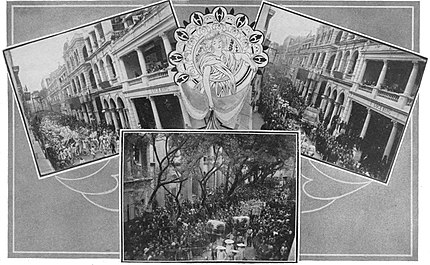all nationalities, was estimated at 15,000, or thrice as many as six months previously. By 1848 the total had increased to 21,514. A rebellion which broke out in the provinces adjacent to Canton in the early fifties sent a flood of emigrants to Hongkong, and the population rose to nearly 40,000 in 1853, and to 75,500 in 1858. Between 1860 and 1861, when the peninsula of Kowloon was added to the Colony, the numbers increased from 94,917 people to 119,321, but from that date onward to 1872 very little progress was made. Four years later, however, a census revealed 139,144 souls, due in part to the influx of some hundreds of Portuguese families from Macao after the destructive typhoon of 1874. In 1881 there were in the Colony 150,000 Chinese, and 9,622 British, Portuguese, and other non-Chinese inhabitants. To-day the population of the Colony—exclusive of the New Territory, which is estimated to contain about 85,000 Chinese—may be set down as 330,000. This figure includes some 9,000 soldiers and sailors, and a floating population of nearly 50,000 Chinese men, women, and children who, from the cradle to the grave, know no home other than their junks, or sampans, afford. The non-Chinese civil community numbers about 10,000, and includes Europeans, Eurasians, Indians, Malays, and Africans.
In the early days of the Colony the ravages of disease were so disastrous that in 1844 the advisability of abandoning the island was seriously discussed. Mr. Montgomery Martin, Her Majesty's Treasurer, drew up a long report in which he expressed the belief that the place would never be habitable for Europeans, and, in support of this statement, he cited the case of the 98th Regiment, which lost 257 men by death in twenty-one months, and of the Royal Artillery, whose strength fell in two years from 135 to 84, from the same cause. General D'Aguilar, the Commander of the Forces, also expressed the opinion that to retain Hongkong would involve the loss of a whole regiment every three years. These gloomy views, however, were not shared by Sir John Davis, the Governor, who stoutly maintained that time alone was required for the development of the Colony and for the correction of some of the evils that hindered its early progress. Sir John lived to see his prediction amply verified. Malarial fever, which proved such a scourge in those days—owing, it seems, to the noxious exhalations from the disintegrated granite disturbed in the course of building operations—has received so much attention from the Medical and Sanitary Departments that its toll of human life is decreasing year by year. The chief causes of mortality now are plague, dysentery, diarrhoea, malarial fever, and small-pox. The death-rate for 1907 was 22·12 per thousand of the inhabitants, but for the non-Chinese community it was as low as 15·46, which compares not unfavourably with many large towns in the United Kingdom. The birth-rate, however, is small. Among the non-Chinese it was equivalent to 15·95 per mille, but for the whole community it was only 4·31 per mille. This latter figure would, no doubt, be somewhat higher but for the Chinese custom of not registering a birth unless the child survives for a month, and often, in the case of a female child, of not registering it at all.
In the jeremiad of Mr. Montgomery Martin, referred to above, the opinion was expressed that it would be a delusion to hope that Hongkong would ever become a commercial emporium like Singapore. Again the progress of events has shown Mr. Martin to be a false prophet, for Hongkong is now the pivot upon which the trade of South China turns. Although, in accordance with the understanding given to the Chinese by Sir H. Pottinger when negotiating the Nanking Treaty, the port is free, and, therefore, no official record of the exports and imports is compiled, the annual value of the trade is estimated at no less than fifty millions sterling. A comparatively small but increasing proportion of this trade consists of local manufactures. In respect of tonnage, Hongkong is the largest shipping port in the world. In 1907 the total tonnage entered and cleared amounted to 36,000,000 tons. To this total ocean-going steamers and war vessels exceeding 60 tons contributed about 19,500,000 tons, of which more than one-half—to be exact, 11,846,533 tons—was British.
The harbour—one of the most extensive and picturesque in the world—consists of the sheltered anchorage lying between the northern shore of the island and the opposite mainland. It varies in width from a third of a mile at the Ly-ee-mūn Channel, on the east, to 3 miles at the widest point, and has an area of 10 square miles. On either side the hills and mountains stand guard like silent sentinels, and combine to produce a spectacle of impressive grandeur. The intervening stretch of water is at all times thickly studded with vessels of every conceivable

